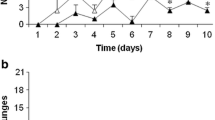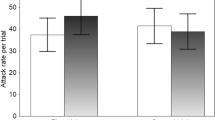Abstract
This study explores the effect of the length of learning period on capture rate of a previously unfamiliar prey by an invasive freshwater crayfish (Procambarus clarkii). Juvenile crayfish were subjected to different periods of contact (learning period) with a larvae prey (Chaoborus sp.). The length of the learning period significantly affected the number of prey consumed by the predator. Our results indicate that the naive crayfish require less than 12 h to learn to maximize capture rate of this prey. The learning coefficient, adopted in the present study, may be useful in exploring predation capabilities of alien species in newly invaded habitats.

Similar content being viewed by others
References
Acquistapace P, Hazlett BA, Gherardi F (2003) Unsuccessful predation and learning of predator cues by crayfish. J Crust Biol 23:364–370
Anastácio PM, Parente VS, Correia AM (2005) Crayfish effects on seeds and seedlings: identification and quantification of damage. Freshw Biol 50:697–704
Avault JW, Brunson MW (1990) Crawfish forage and feeding systems. Rev Aquat Sci 3:1–10
Berendonk TU (2002) Distribution and ecology of phantom midge larvae in southern France and Italy (Diptera: Chaoboridae). Stud Dipterol 9:1–4
Bezerra-Neto JF, Pinto-Coelho RM (2002) The influence of the Chaoborus brasiliensis (Theobald, 1901) (Diptera, Chaoboridae) larvae in the zooplankton vertical distribution at Nado Lagoon, Belo Horizonte, state of Minas Gerais, Brazil. Acta Sci Biol Sci 24:337–344
Borkent A (1981) The distribution and habitat preferences of the Chaoboridae (Culicomorpha: Diptera) of the Holarctic Region. Can J Zool 59:122–133
Campos MR (2005) Procambarus (Scapulicambarus) clarkii (Girard, 1852), (Crustacea: Decapoda: Cambaridae) Una langostilla no nativa en Colombia. Acad Colombiana Cienc Exactas Físicas y Nat 111:295–302
Chivers DP, Wisenden BD, Smith RJ (1996) Damselfly larvae learn to recognize predators from chemical cues in the predator’s diet. Anim Behav 52:315–320
Collins HP (1998) Laboratory evaluation of the freshwater prawn, Macrobrachium borellii, as a predator of mosquito larvae. Aquat Sci 60:22–27
Correia AM (2002) Niche breadth and trophic diversity: feeding behaviour of the red swamp crayfish (Procambarus clarkii) towards environmental availability of aquatic macroinvertebrates in a rice field (Portugal). Acta Oecol 23:421–429
Correia AM (2003) Food choice by the introduced crayfish Procambarus clarkii. Ann Zool Fenn 40:517–528
Correia AM, Anastácio PM (2008) Shifts in aquatic macroinvertebrate biodiversity associated with the presence and size of an alien crayfish. Ecol Res 23:729–734
Correia AM, Bandeira N, Anastácio PM (2005) Predator–prey interactions of Procambarus clarkii with aquatic macroinvertebrates in single and multiple prey systems. Acta Oecol 28:337–343
Correia AM, Bandeira N, Anastácio PM (2007) Influence of chemical and visual stimuli in food-search behaviour of Procambarus clarkii under clear conditions. Mar Freshw Behav Phy 40:189–194
Covich AP, Dye LL, Mattice JS (1981) Crayfish predation on corbicula under laboratory conditions. Am Midl Nat 105:181–188
Cruz MJ, Rebelo R, Crespo EG (2006) Effects of an introduced crayfish, Procambarus clarkii, on the distribution of south-western Iberian amphibians in their breeding habitats. Ecography 20:329–338
Derby CD, Steullet P, Horner AJ, Cate HS (2001) The sensory basis of feeding behaviour in the Caribbean spiny lobster, Panulirus argus. Mar Freshw Res 52:1339–1350
Dukas R (2008) Evolutionary biology of insect learning. Annu Rev Entomol 53:145–160
Fernandes TF, Huxham M, Piperb SR (1999) Predator caging experiments: a test of the importance of scale. J Exp Mar Biol Ecol 241:137–154
Garcia EA, Mittelbach GG (2008) Regional coexistence and local dominance in Chaoborus: species sorting along a predation gradient. Ecology 89:1703–1713
Gherardi F (2006) Crayfish invading Europe: the case study of Procambarus clarkii. Mar Freshw Behav Phy 39:175–191
Gherardi F, Acquistapace P (2007) Invasive crayfish in Europe: the impact of Procambarus clarkii on the littoral community of a Mediterranean lake. Freshw Biol 52:1249–1259
Gherardi F, Renai B, Corti C (2001) Crayfish predation on tadpoles: a comparison between a native (Austropotamobius pallipes) and an alien species (Procambarus clarkii). Bull Fr Peche Pisc 361:659–668
Gherardi F, Acquistapace P, Hazlett B, Whisson G (2002) Behavioural responses to alarm odours in indigenous and non-indigenous crayfish species: a case study from Western Australia. Mar Fresh Res 53:93–98
Ghosh SK, Mandal BK, Borthakur DN (1984) Effects of feeding rates on production of common carp and water quality in paddy cum fish culture. Aquaculture 40:97–101
Haefner JW (1996) Modeling biological systems. Principles and applications. ITP, Chapman & Hall, New York
Harmsen K, Matar AE, Saxena MC, Silim SN (2001) Yield response to phosphorus fertilizer in a wheat-lentil rotation in a Mediterranean environment. Netherlands J Agric Sci 49:385–404
Hazlett BA (1994) Crayfish feeding responses to Zebra Mussels depend on microorganisms and learning. J Chem Ecol 20:2623–2630
Hazlett BA (2000) Information use by an invading species: do invaders respond more to alarm odours than native species? Biol Invasions 2:289–294
Hazlett BA, Schoolmaster DR (1998) Responses of cambarid crayfish to predator odour. J Chem Ecol 24:1757–1770
Hazlett BA, Acquistapace P, Gherardi F (2002) Differences in memory capabilities in invasive and native crayfish. J Crust Biol 22:439–448
Hazlett BA, Burba A, Gherardi F, Acquistapace P (2003) Invasive species use broader range of predation-risk cues than native species. Biol Invasions 5:223–228
Hobbs HH, Jass JP, Huner JV (1989) A review of global crayfish introductions with particular emphasis on two North American species (Decapoda: Cambaridae). Crustaceana 56:229–316
Hughes RN, Seed R (1995) Behavioural mechanisms of prey selection in crabs. J Exp Mar Biol Ecol 193:225–238
Ilhéu M, Guilherme P, Bernardo JM (2002) Impact of the red swamp crayfish (Procambarus clarkii) on aquatic invertebrate and macrophyte assemblages: a case study in the south of Portugal. Verh Int Ver Limnol 28:144–147
Ishii Y, Shimada M (2010) The effect of learning and search images on predator–prey interactions. Popul Ecol 52:27–35
Jover M, Férnandez-Carmona J, Del Río MC, Soler M (1999) Effect of feeding cooked-extruded diets, containing different levels of protein, lipid and carbohydrate on growth of red swamp crayfish Procambarus clarkii. Aquaculture 178:127–137
Karavanich C, Atema J (1998) Individual recognition and memory in lobster dominance. Anim Behav 56:1553–1560
Karplus I, Katzenstein R, Goren M (2006) Predator recognition and social facilitation of predator avoidance in coral reef fish Dascyllus marginatus juveniles. Mar Ecol Prog Ser 319:215–223
Lawton JH, Beddington JR, Bonser R (1974) Switching in invertebrate predators. In: Usher MB, Williamson MH (eds) Ecological stability. Chapman & Hall, London, pp 141–158
Lencioni M, Wilhlem DFM (2006) Prey selection by Chaoborus in the field and laboratory. J Young Investig 15(4). http://www.jyi.org/research/re.php?id=777
Lodge DM, Shrader-Frechette K (2003) Nonindigenous species: ecological explanation, environmental ethics, and public policy. Conserv Biol 17:31–37
Mascaró M, Seed R (2001) Choice of prey size and species in Carcinus maenas (L.) feeding on four bivalves of contrasting shell morphology. Hydrobiologia 449:159–170
McCarthy TM, Dickey BF (2002) Chemically mediated effects of injured prey on behavior of both prey and predators. Behaviour 139:585–602
Mikoji GM, Boyce TG, Mungai BN, Copeland RS, Hofkin BV, Loker ES (1999) Predation of aquatic stages of Anopheles gambiae by the Louisiana red swamp crayfish (Procambarus clarkii). J Am Mosquito Contr 15:69–71
Mitscherlich EA (1909) Des Gesetz des Minimums und das Gesetz des abnehmended Bodenertrages. Landwirsch Jahrb 3:537–552
Nijland GO, Schouls J, Goudriaan J (2008) Integrating the production functions of Liebig, Michaelis-Menten, Mitscherlich and Liebscher into one system dynamics model. NJAS Wageningen J Life Sci 55:199–224
Nyström P, Brönmark C, Granéli W (1999) Influence of an exotic and a native crayfish species on a littoral benthic community. Oikos 85:545–553
Papaj DR, Prokopy RJ (1989) Ecological and evolutionary aspects of learning in phytophagous insects. Annu Rev Entomol 34:315–350
Renai B, Gherardi F (2004) Predatory efficiency of crayfish: comparison between indigenous and non-indigenous species. Biol Invasions 6:89–99
Roudez RJ, Glover T, Weiss JS (2008) Learning in an invasive and a native predatory crab. Biol Invasions 10:1191–1196
Sala OE, Chapin FS, Armesto JJ, Berlow E, Bloomfield J, Dirzo R, Huber-Sannwald E, Huenneke L, Jackson R, Kinzig A, Leemans R, Lodge DM, Mooney HA, Oesterheld M, Poff NL, Sykes MT, Walker BH, Walker M, Wall DH (2000) Biodiversity scenarios for the year 2100. Science 287:1770–1774
Sell AF (2006) A trophic cascade with Chaoborus: population dynamics of ex-ephippial generations of Daphnia. Arch Hydrobiol 167:115–134
Siebeck UE, Litherland L, Wallis GM (2009) Shape learning and discrimination in reef fish. J Exp Biol 212:2113–2119
Stenroth P, Nyström P (2003) Exotic crayfish in a brown water stream: effects on juvenile trout, invertebrates and algae. Freshw Biol 48:466–475
Tuthill JC, Johnsen S (2006) Polarization sensitivity in the red swamp crayfish Procambarus clarkii enhances the detection of moving transparent objects. J Exp Biol 209:1612–1616
Williams CE (2001) Review: biological invasions and global change: what might the future bring? Ecology 82:1498–1499
Wisenden BD, Chivers DP, Smith RJ (1997) Learned recognition of predation risk by Enallagma damselfly larvae (Odonata, Zygoptera) on the basis of chemical cues. J Chem Ecol 23:137–151
Zar JH (1996) Biostatistical analysis, 3rd edn. Prentice-Hall, New Jersey
Acknowledgments
This work was funded by the National Foundation for Science and Technology (FCT) by a PhD grant (SFRH/BD/19373/2004), the project POCTI/BSE/46862/2002 and by FEDER. Thanks are due to Dr. W. Ray McClain for the manuscript review and comments before submission.
Author information
Authors and Affiliations
Corresponding author
About this article
Cite this article
Ramalho, R.O., Anastácio, P.M. Crayfish learning abilities: how does familiarization period affect the capture rate of a new prey item?. Ecol Res 26, 53–58 (2011). https://doi.org/10.1007/s11284-010-0754-7
Received:
Accepted:
Published:
Issue Date:
DOI: https://doi.org/10.1007/s11284-010-0754-7




